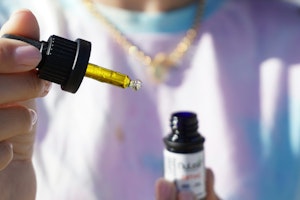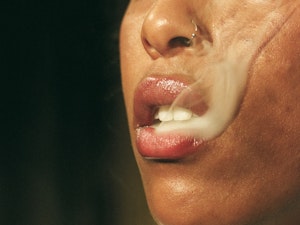
PHOTO BY KAYA BLAZE KELLEY FOR HERB
What Is THCV? Main Benefits & Effects
As cannabis research progresses, we're realizing that it's not just about THC and CBD; there's a whole host of other phytocannabinoids waiting to be discovered and understood.
One of these intriguing compounds is Tetrahydrocannabivarin, or THCV for short, a minor cannabinoid with major potential.
In many ways, THCV is still shrouded in mystery. It’s a minor cannabinoid, meaning it’s typically found in lower concentrations than its major counterparts like cannabigerolic acid or delta9-tetrahydrocannabivarin. Yet, it’s an exciting area of exploration in cannabis research, primarily due to its distinctive effects and potential benefits that set it apart from other cannabinoids.
THCV is often referred to as “diet weed,” a moniker that piques curiosity and leaves many wondering why such a name was chosen. What properties does THCV possess that earns it such an unusual nickname? Is it an appetite suppressant, as the name suggests, or does it have other notable characteristics? Furthermore, does it share the psychoactive properties of THC, or does it present an entirely different set of effects?
Then there’s the question of legality, a complex issue that mires most things cannabis related. How does THCV fare in the legal landscape? Is it universally legal, or does its legality vary from place to place?
Finally, what are the practical applications of THCV? Where can it be found, and in what forms is it available?
This article aims to answer all these questions and more, taking a deep dive into the world of THCV. From its unique effects and potential benefits to its legality and sources, we’ll explore everything you need to know about this fascinating cannabinoid. Whether you’re new to the world of cannabinoids or a seasoned enthusiast, the following exploration of THCV promises a wealth of knowledge and understanding. So, join us on this journey into the remarkable universe of cannabinoids as we uncover the mystery of THCV.
What Is THCV? Main Benefits & Effects
Tetrahydrocannabivarin, or THCV, is one of the many compounds known as phytocannabinoids found in the cannabis plant. Despite being classified as a minor cannabinoid, it has a fascinating molecular structure and a unique set of properties that distinguish it from other cannabinoids.
To understand THCV, we need to go back to the plant’s origins. The cannabis plant is a treasure trove of compounds, with more than a hundred different cannabinoids discovered to date. Among these cannabinoids are the well-known CBD (cannabidiol) and THC (delta-9-tetrahydrocannabinol), along with a host of other compounds that contribute to the plant’s therapeutic potential. However, despite sharing similar names and originating from the same plant, THCV and THC have important differences that set them apart.
Unlike THC, which is the primary psychoactive compound in cannabis responsible for the intoxicating effects, THCV has a varied interaction with our body’s endocannabinoid system, the biological system that cannabinoids bind to. Like other cannabinoids, THCV interacts with the CB1 and CB2 receptors in our endocannabinoid system, but its effects can be significantly different from THC or CBD.
At low doses, THCV acts as a CB1 antagonist, which means it blocks the receptor and reduces the effects of other cannabinoids. This interaction is what lends THCV its appetite-suppressant properties, leading to its nickname as the “diet weed”. However, at higher doses, THCV can act as a CB1 agonist, which means it activates the receptor much like THC, albeit with less intoxicating effects.
THCV is also synthesized differently in the cannabis plant compared to other cannabinoids. While most cannabinoids, including THC, originate from cannabigerolic acid (CBGA), THCV stems from cannabigerovarin acid (CBGVA). The unique biosynthetic pathway of THCV potentially contributes to its unique properties.
In terms of its presence in the plant, THCV is typically found in higher concentrations in sativa strains, particularly those from Africa. However, its overall concentration is generally lower compared to major cannabinoids, hence its classification as a minor cannabinoid.
The study of THCV is still in its nascent stages, and the more we learn about it, the more potential it seems to hold. In the following sections, we will delve into the effects of THCV, its potential benefits, its legality, and its presence in different cannabis strains and products.
As we move forward in our understanding of cannabis and its constituents, it’s increasingly clear that minor cannabinoids like THCV have significant roles to play in broadening our knowledge and potentially offering new and unique therapeutic benefits. It’s a remarkable reminder of the untapped potential within the world of cannabis, waiting to be discovered.
Effects Of THCV

While sharing some similarities with its psychoactive cousin THC, THCV distinguishes itself through unique effects:
Effect 1: Non-Intoxicating
Unlike THC, which is famous (or infamous) for its intoxicating effects, THCV doesn’t induce the “high” sensation commonly associated with cannabis consumption. This characteristic is particularly appealing to those who are interested in experiencing the potential benefits of cannabinoids without the psychoactive effects.
Effect 2: Neuroprotective
Emerging research suggests that THCV may possess neuroprotective properties. This potential effect could make it a promising therapeutic candidate for neurological conditions, such as Parkinson’s disease, where neuroprotection could help slow the disease progression.
Effect 3: Appetite Suppressant
Contrary to most other cannabinoids, which are known for their appetite-stimulating properties, THCV may act as an appetite suppressant. This unique feature has led to THCV being termed as “diet weed,” a nickname that signifies its potential role in weight management.
THC + THCV Uplift Gummies
These innovative THC + THCV Gummies are a fusion of dreamy relaxation and energizing vitality in a delicious sweet lemon-flavored edible.
These Uplift gummies are meticulously formulated to give you the best of both worlds. THC offers dreamy relaxation, temporary relief from nausea, and occasional relief from discomfort, all derived from legal U.S. industrial hemp. With only 2.5mg of THC per gummy, you can ease stressful situations or add sparkle to your night out without the overwhelming effects.
What sets these Uplift gummies apart is the inclusion of THCV, which has the opposite effects of THV by controlling appetite, increasing energy, and improving focus and concentration. These gummies contain an unprecedented 12.5 mg of THCV per serving, making them the highest THCV content gummies available.
At Rare Cannabinoid Company they have carefully selected a full-spectrum hemp oil with a well-thought-out ratio of THCV to THC, ensuring that the energizing effects of THCV are not overshadowed by THC.
To further elevate the experience, each gummy contains 10mg of CBD, which promotes stress resistance, balance, calmness, and overall relief. This full-spectrum blend creates an entourage effect, maximizing the impact of each compound.
Why Is THCV Called Diet Weed?
Within the myriad compounds found in cannabis, THCV stands out for its purported appetite-suppressing effects, which is a departure from the norm. Most cannabinoids, including THC, are known for their appetite-stimulating properties, often termed “the munchies”. However, THCV seems to march to a different beat, hence earning it the moniker “diet weed.”
Is THCV an Appetite Suppressant?
As mentioned, THCV may counteract the typical appetite-stimulating effect of other cannabinoids. This action is due to its potential role as an antagonist of the CB1 receptor, one of the major targets of cannabinoids in the body. By blocking this receptor, THCV could dampen the hunger signals, resulting in a reduction in appetite. While these findings are promising, it’s important to note that more extensive research is required to fully comprehend the mechanisms behind this effect and its potential applications in weight management.
Benefits Of THCV

As our understanding of THCV expands, several potential benefits have come to light:
Benefit 1: Antioxidant
Like many other cannabinoids, THCV may exhibit antioxidant properties. Antioxidants are compounds that help to counteract the damaging effects of free radicals in the body, thus reducing oxidative stress. Oxidative stress is linked with a host of health issues, from aging and inflammation to chronic diseases, and having natural antioxidants in our system can help combat these adverse effects.
Benefit 2: Diabetes Control
Preliminary studies suggest that THCV could help regulate blood sugar levels and reduce insulin resistance, which is a common issue in type 2 diabetes. This potential benefit could make THCV a promising avenue for developing new therapeutic approaches for diabetes management.
Benefit 3: Parkinson’s Disease
Early research on THCV’s neuroprotective properties suggests its potential as a therapeutic agent for managing Parkinson’s disease. These studies indicate that THCV could potentially protect brain cells from damage and slow the progression of this disease. However, these findings are in their preliminary stages, and more comprehensive human trials are needed.
Is THCV Legal?
When it comes to legality, THCV falls into a gray area that varies significantly across different jurisdictions. In some places, the legal status of THCV may depend on its source – if it’s derived from hemp (Cannabis sativa plants with less than 0.3% THC), it may be considered legal, while THCV extracted from marijuana (Cannabis sativa plants with more than 0.3% THC) might not be. It’s crucial for consumers to check the local laws and regulations before purchasing or using any products containing THCV.
High-THCV Strains & Products
While THCV is typically found in lower concentrations in most cannabis strains, there are a few strains known for their higher-than-average THCV content. These include Douglas Fir, Durban Poison, and Pineapple Purps. In addition to these strains, various THCV-enriched products are also available on the market. One such product is Monnwlkr THCV Gummies, a convenient way to incorporate this intriguing cannabinoid into one’s wellness routine.
Whether you’re considering strains or products, always remember that the safety and efficacy of cannabis products largely depend on the quality of the source and the manufacturing practices. Regularly updated product testing and certification can help ensure the product you choose is safe and reliable. As with any new supplement, always consult with a healthcare professional before incorporating THCV into your routine to ensure it’s the right choice for your individual needs and circumstances.
Herb Recommended Products:
READ MORE











